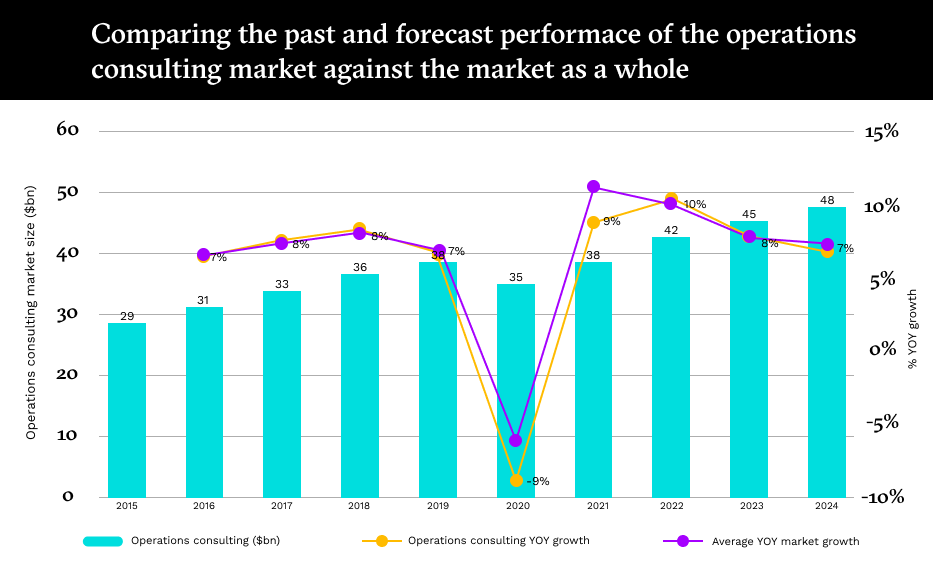Productivity improvement is more important than ever — but what does this mean for firms?
The need to drive up productivity is nothing new. But to what extent do consulting and professional services firms benefit from a market in which it’s rapidly becoming even more important?
For the past seven years, we’ve been asking the senior executives who typically buy consulting and other professional services what their strategic priorities are: Productivity improvement has come top of that list every year. Eighty-six percent of clients say that it’s a long-standing concern, reinforcing swathes of research about the productivity paradox. That is the stubborn and scarcely closing gap between the amount invested in improving productivity, largely through technology, and the actual improvement it delivers. Failing to find in-house solutions, clients have looked to external suppliers for help, giving rise to a global operations consulting market that’s currently worth around $42bn.
Given clients’ widespread and increasingly serious concerns about economic turmoil and the threat of a global recession, we might predict that productivity-related services look set to grow significantly higher than the market rate. But we’re more cautious for three reasons.
First is evidenced by the relatively poor performance of productivity consulting during the pandemic, when we estimate that demand fell by 9%, compared to 6% across the market as a whole. Although operations consulting grew at three percentage points below the average in 2021, most of this surge in activity was pent-up demand from the pandemic, not new growth. Prior to the pandemic operations consulting growth was in line with the market. Performance has been unimpressive because clients could see no sign of innovation from the supply side: Six Sigma and its successor, Lean Six Sigma—arguably the dominant productivity methodologies of the last 30 years—are very familiar to clients and widely practiced by them. What clients were looking for—if they were to be persuaded to significantly increase their expenditure on productivity consulting—was innovation and this data suggests they didn’t find it.

Note: Percentages on the growth line are for operations consulting
This leads us to the second reason underpinning the poor performance of this market. Research we’ve completed in late August suggests that around a third of clients think that the solution to productivity issues lies, not in traditional advisory work, but in technology. A further quarter point to improved data and analytics. Traditional approaches, notably laying off staff, will be almost impossible to implement in an environment when 60% of clients describe themselves as being very short-staffed: Only 4% of clients we surveyed regarded this as a viable strategy. This means that what might have been growth in operations consulting is being cannibalised by technology growth—indeed, it’s one of the reasons why operations consulting firms haven’t invested sufficiently.
The third and final reason stems from clients themselves. Perhaps as a result of that lack of innovation and investment, 42% of clients expect to solve the productivity paradox themselves: They have, it appears, little faith in the ability of consulting firms to do so. Why? Having spent the years since the global financial crisis failing to resolve the productivity paradox, they know that any solution will be very complex and highly customised to their own organisations. Generic solutions won’t produce the accumulation of marginal gains they’ll have to find. Forty percent of clients say that one of the two biggest disincentives to using consulting services in this space is that they, clients, are better placed to spot potential improvements. Consultants, by contrast, rarely have the depth of knowledge required. But clients are also concerned that they won’t get good value for money from using consultants: 27% of clients said that consultants are simply too expensive; 23% that consultants don’t have a tangible impact, and that it looks bad spending money on consultants at a time when clients are cutting costs elsewhere. Almost the same proportion felt that it’s hard to measure the impact consultants have, that they weren’t sure what they’d get for their money, and that any improvements delivered would prove to be temporary. One in ten clients said they’d learn nothing new.
Productivity improvement could be a substantial growth opportunity for consulting and professional services firms—but only if they can demonstrate they can have a material impact.
As with so many things in life, it pays to be prepared. Source provides briefings and presentations for senior leadership discussions and helps professional services firms plan scenarios for their own businesses. If you’d like to know more, please get in touch.